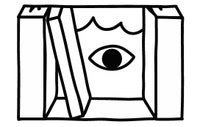
Frank Modell, a classically trained artist who contributed more than 1,400 cartoons to The New Yorker — customarily, he said, “of angry men and sexy women and dogs” — during an illustrious era for the magazine, died on Friday at his home in Guilford, Conn. He was 98.
A friend, Florence Hammond, confirmed his death.
For more than 50 years, beginning in 1946, Mr. Modell’s moon-faced characters leapt from The New Yorker’s pages in a perpetual state of exasperation or pandemonium, evoking for readers their everyday vexations.
“The best compliment I ever had was from a young lady who liked a cartoon of mine,” he recalled in 1988. “She said, ‘It said something I knew, but didn’t know I knew.’”
His two-dimensional fun-house mirror reflected life’s little absurdities:
Columbus plaintively appeals to a skeptical Queen Isabella, who demands: “Three ships is a lot of ships. Why can’t you prove the world is round with one ship?” Two elephants eye a third dubiously as one says to the other: “You know the type. Remembers only what he wants to remember.” A mean-looking woman who has just shot her husband says into the telephone: “And one more thing, Lieutenant. Tell your men to wipe their shoes before they come tramping in here.”
“Modell is the quintessential gag cartoonist,” Richard Calhoun, a social historian, wrote in “The World Encyclopedia of Cartoons” (1980).
Mr. Modell also drew six covers for The New Yorker, illustrated books for children, drew for Playboy (fewer of the angry men and dogs) and, in 1978, published a collection of his work, “Stop Trying to Cheer Me Up!”
He had no illusions about the role his cartoons played at The New Yorker, well known for its long articles: to break up “great slabs of type,” as he put it.

Franklyn Bruce Modell was born in Philadelphia on Sept. 6, 1917, the only child of Irving Modell and the former Daisy Simon. His father, an immigrant from Russia, was a traveling furniture salesman.
Frank began to draw at 6, when he was quarantined with scarlet fever. His father had given him pencils, crayons and a sheaf of hotel stationery from his travels. His parents, his doctor and the cleaning woman lauded his illustrations.
“It wasn’t so much the art I enjoyed,” he wrote in “Stop Trying to Cheer Me Up!” “It was the visibility I was getting.”
His father, an excitable man, became an inspiration for Mr. Modell’s future angry men. When Irving Modell became enraged, Frank would watch “the way anger worked on the topography of his face just inches from mine,” he wrote, “the narrowed eyes, the vertical furrow between the brows, the inflated nostrils.”
That he was more interested in art than athletics came to bother his father, Mr. Modell was quoted as saying in “The Life, Loves and Laughs of Frank Modell” (2013), a book by James Stevenson, a fellow cartoonist.
But he became popular with his classmates, impressing them with his portraits of Lincoln drawn from pennies.
After graduating from the Philadelphia Museum School of Industrial Art, he was drafted into the Army and served in Europe during World War II as a sergeant with a signal radio intelligence company.
“All that time I was sending cartoon ideas to The New Yorker magazine,” he recalled on his website. “When the war was over, I married, got divorced, and joined the New Yorker staff.”

No immediate family members survive.
Mr. Modell was hired as an assistant to the magazine’s art editor, James Geraghty.
“I was a hit man,” he told The New York Times in 2000. “If an idea was O.K.’d, Geraghty would see the cartoonist. But if it was a rejection, he would say, ‘Frank will see him.’ The mortality rate was worse than for babies in 1910 Egypt.”
Mr. Modell’s first New Yorker cartoon appeared in the issue of July 20, 1946. It depicted a couple at the beach in bathing suits. The man asks the stupefied woman, “I don’t suppose you happen to have a match on you, do you?”
His cartoons and covers would appear for the next 50 years, under the editors Harold Ross and William Shawn.
Mr. Modell, who once said that he had “no expectations for a postdeath social life,” took pleasure in mocking mortality in his cartoons.
In one, an ornery old man being examined by his doctor demands, “You’re going to keep on looking until you find something — aren’t you?” In another, two women are shopping for get-well cards when one says to the other: “He looked dreadful when I last saw him. Maybe I should shoot right for the sympathy cards.”
Mr. Modell, who moved to Guilford in the early 1980s, carried a sketchbook in his pocket into his 90s. But he seemed to subscribe to the view that few cartoonists leave an enduring legacy, a notion echoed by Iain Topliss in his book “The Comic Worlds of Peter Arno, William Steig, Charles Addams and Saul Steinberg” (2005). “Instantly enjoyable and instantly disposable, the single-panel comic cartoon is also instantly forgettable,” Mr. Topliss wrote.
He quoted Mr. Modell in the book as recounting this conversation at a party:
“What do you do?”
“I’m a cartoonist.”
“I love cartoons. Where do you publish?”
“The New Yorker.”
“I love The New Yorker. What’s your name?”
“Frank Modell.”
“Yes? [Pause.] I’ve never heard of you.”












沒有留言:
張貼留言